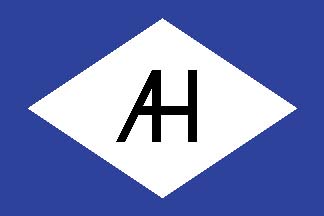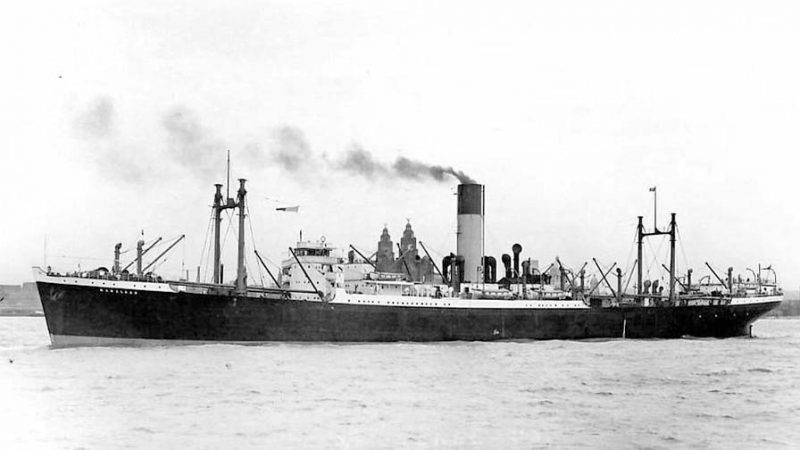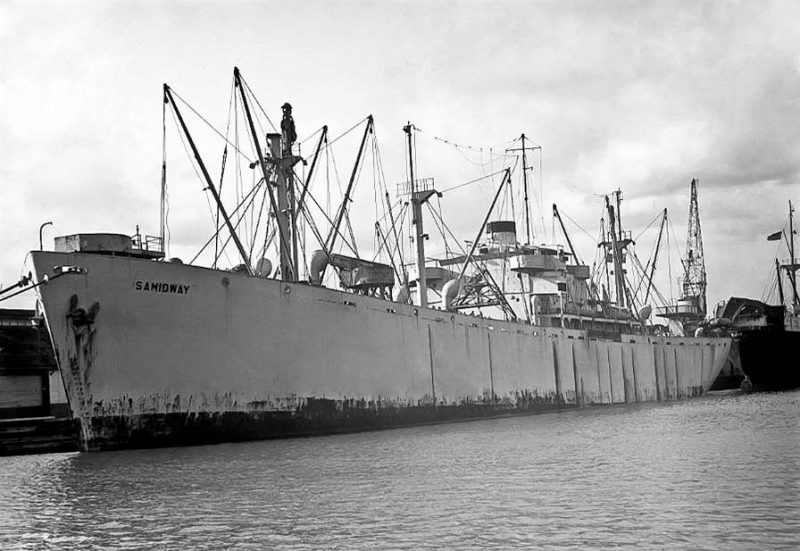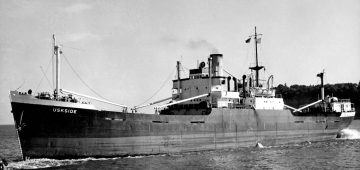By Captain J Main

 I left Gordonstoun School at the end of the Summer Term 1943, having completed a five year scholarship from Alfred Holt & Co. Prior to this I had attended the first course in 1941 at the Aberdovey Seaschool and two further courses by which time the courses were established as the Outward Bound School.
I left Gordonstoun School at the end of the Summer Term 1943, having completed a five year scholarship from Alfred Holt & Co. Prior to this I had attended the first course in 1941 at the Aberdovey Seaschool and two further courses by which time the courses were established as the Outward Bound School.
I was born in 1926 in Burghead (Morayshire), my father was a part owner of a Drifter/Trawler and spending some eight months of the year trawling from Fleetwood and about three months on Drift Net from Great Yarmouth. We were a family of seven (five boys and two girls) and my father didn’t want me to go fishing and he was happy that I gained a scholarship at Gordonstoun.
Liverpool then advised me to report to the Midshipmen’s Hostel at Rivers Dale Road where I signed my Indentures for four years this being registered and a talk about the company. The following day I, together with several Midshipmen travelled by train to India Buildings’ temporary Office. The next day I was accompanied by another Midshipman to visit the Sailors Home to be kitted out according to a standard list of clothing, not forgetting my toupee.
I then returned to the Navigation Class on Chartwork. We spent two days at the office and then I was instructed to join with three other Midshipmen and proceed to Glasgow to join the Menelaus at King George V Dock. The other three had sailed together on Lycaon and had their leave. We reported to the Marine Superintendent and then we were free to join Menelaus.
Menelaus was built in 1923 at Caledon Shipbuilders in Dundee, 10,277 grt, 9 hatches, a coal burner, 100 tons of coal per day to give a speed of 14 knots. She had no radar or Gyro Compass.
We boarded the vessel to find ashes to a height of some three feet on the deck by the gangway and a path cleared from the gangway to the entrance to the accommodation. We found our room was one deck down (on the main deck) on the starboard forward corner, along with other passenger accommodation in the same alleyway. The room was about 15 x 10 feet, with four bunks, a small table and wardrobe, there was no running water but a compactum – a piece of fitted furniture, with a wash hand basin inside and an enamel bucket underneath to allow for spillage on the deck. The nearest running water was salt water at the end of the passenger alleyway.

All four of us were engaged in work on the bridge, repairing code flags and cleaning brasswork and attending deliveries of ropes etc for the coming voyage. On one day before sailing all four of us attended a day gunnery course which we found very interesting.
We than sailed in convoy from Gourock to cross the Atlantic for destination Newport News to replenish our coal bunkers.
During this sea passage the officers were on double watches, with two midshipmen on bridge work and the other two on day work. The day work was with the bosun, apart from filling the Captain’s water tank from a connection adjacent to his room. One of us attended on the Bridge at noon to get details of our noon position and the nearest land in the event of possible attack/torpedo, this information was fitted in water tight tins and in the locker of each lifeboat. An inspection was also required about sunset to ensure that the blackout was correct and this was reported to the Senior Officer on the bridge.
I was on duty on the Bridge on the middle watch when I thought I saw a submarine on our port side and reported to the Chief Officer and he told me to call the Captain. I opened his door and it was fitted with a special catch and the lights inside the cabin went out and I got lost until the Captain closed the door, the Chief Officer sounded the alarm and the order was made to fire the Bridge Orelekon Gun and it transpired that it was the boot topping of the ship adjacent, nothing was said from this ship, the tracer bullets showed up the ship in full, no harm was done.
On arrival at Newport News the U.S. immigration would not allow our Chinese Engine crew to land ashore and there were armed soldiers on the wharf to ensure that Chinese didn’t land. However, the Captain arranged with the U.S. authorities that the crew could land under escort and our bond held for all of them to return.
We successfully bunkered and sailed in convoy to the Panama Canal where we were stored and then transitted the Canal. This to me was great I had seen literature on this but it really was wonderful. On departure from the Canal we headed for Sydney (Australia) this time at full speed (no convoy).
About half way to Sydney we sighted another ship on a reverse course and the alarm was sounded with “Action Stations” until passed and clear. It was an American Liberty ship bound for the Panama Canal.
On this passage we transferred coal from number 4 hatch trunk to the bunker hatch using derricks and winches and large canvas slings the coal had been loaded at Glasgow and was a very difficult and dirty job.
On arrival at Sydney we moored at the Quay almost under the harbour bridge. Our first discharge was cattle from the structure on the well deck, cows and bulls, and a horse which was loaded in Glasgow, we had a short training period on loading and how to attend them. The person receiving the animals gave us a generous present and we all four went to the races under his expert guidance.
Whilst discharging cargo we worked with the Deck Officers, a lot of the times being watchmen down the hatches. We had a lot of high value cargo especially whisky in barrels, the dockers were experts at sampling the contents.
We thoroughly enjoyed our stay in Sydney, where we spent a lot of time at the Mission to Seamen, including an excellent picnic on the beach.

Our next port of call was Melbourne where we completed the discharge of cargo. Again as we didn’t have a lot of money, we visited the Mission to Seamen on various occasions. At a slack period during discharge the Chief Officer gave us a day off.
The ship was now empty of cargo, we proceeded to Newcastle to take the maximum bunkers.
Then back to Sydney for loading of U.K. cargo, a lot of which was bales of wool, and food items, sorely needed in U.K.
Our senior midshipman sat and passed for his 2nd Mates Certificate, and that left only three of us to carry out our duties.
On completion of loading we sailed for Panama at maximum speed, and then through the canal and on to Halifax, Nova Scotia in convoy. After replenishing our bunkers we sailed in convoy to Liverpool, thus completing my first voyage.
A lot of the time we worked with the Bosun and deck crew on the homeward voyage doing general maintenance to make the vessel presentable on arrival in U.K., all of which was good training for my future career at sea. I learned to steer the vessel and completed the prescribed navigation written work for handing into the Midshipmen’s Department at Liverpool.
I forgot to say that I had my 18th birthday in Sydney.
We had been away for six months which allowed us 2.5 weeks leave.
On return from home leave it was back to Liverpool together with one of my ship mates from Menelaus where we signed for service in a brand new Liberty Ship to be built in U.S.A. We, together with a full crew travelled by train to Gourock where we joined the Queen Elizabeth as passengers to New York. We were allocated a room for 18 people where the bunks were three high, and only salt water in the bathroom. There were water stations just off the main alleyway and you took your towel and washbag there. The room was probably for two or three passengers on pre-war voyages.
The food was good as was the service, there was entertainment during the afternoon and evenings including cinemas. We as Midshipmen offered our services as lookouts but there were too many volunteers.
On arrival in New York we were accommodated at the Hotel Barbazon Plaza for a few days prior to travelling to Portland, Maine where we stayed at another Hotel quite near where the Samidway was being built.

We visited the shipyard daily and we were employed checking stores etc. It was quite a good experience to watch the fitting out particularly as the whole midship house was lifted by crane and positioned on the deck and welded around the bottom, the inside of this house contained furniture and bathrooms all ready for use, this was quite amazing.
When the ship was completed (this was said to be 28 days), trials were held and then the ship was handed over to Captain Evans.
We loaded the vessel at Portland, then on to New York to await a convoy to Glasgow.
The Atlantic Ocean was quite rough but we made it without attack.
Our signing off in Glasgow was one month and twenty four days since we signed on in Liverpool.
A very interesting experience as passenger and then seeing the vessel built.

The next four ships I sailed on were coal burners, then to a motor ship until 1957 when I came ashore.



Comments
Sorry, comments are closed for this item